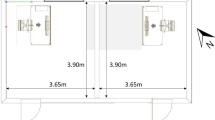Abstract
There are many factors that affect students’ learning efficiency and attention. Studies have shown that a suitable light environment can improve students’ attention, thereby improving learning efficiency. This study explores the effects of different indoor light environments on students’ attention and learning efficiency through eye-brain experiments. First, three experiments with different light environments are designed. By collecting and analyzing electroencephalogram (EEG) data and eye movement data of 6 participants, the effect of light environment on learning attention is studied, and the light environment conditions that are most conducive to concentration were obtained. The results are shown that: (1) The light environment illuminance will affect the comfort and fatigue of participants. Under the light environment of 870 lx–6500 K, the participants were the most tired and could not concentrate own attention. (2) Pre-stimulation before the experiment helps to concentrate attention. In the 300 lx light environment task test, the average accuracy of A-test in the calm group is 6.25% higher than that of the stimulus group, and the average accuracy of the M-test in the stimulus group is 17% higher than that of the calm group. (3) Compared with the 870 lx light environment, the pupil diameter does not change significantly under 570 lx, at this time the comfort is the highest and the fatigue is the lowest. (4) The stimulus group have the highest comprehensive scores under 570 lx-6500 K light environment. The overall performance of the stimulation group was better than the calm group.
Access this chapter
Tax calculation will be finalised at checkout
Purchases are for personal use only
Similar content being viewed by others
References
Fang Y, et al. (2020) Study of human thermal comfort for cyber–physical human centric system in smart homes. Sensors 20(2):372
Wang W, Fang Y, Wang W, et al. (2020) Study on factors correlation of personal lighting comfort model in cyber-physical human centric systems. In: 2020 fifth junior conference on lighting (Lighting). IEEE, pp 1–5
Jintao S, Lei C, Renlai Z (2021) Test anxiety impairs filtering ability in visual working memory: evidence from event-related potentials. J Affect Disord 292:700–707
Peng W et al (2021) Insights into public visual behaviors through eye-tracking tests: a study based on national park system pilot area landscapes. Land 10(5):497–497
Wenmiao W (2018) Research on the influence of indoor illumination and color temperature on work efficiency. Anhui University of Architecture and Architecture
Bakó-Birób Z, Clements-Croomea DJ, Kochhara N (2012) Ventilation rates in schools and pupils’ performance. Build Environ 48:215–223
Mingyue W, Yalong Y, Chenlei X, Bao X (2020) Research on the influence of indoor thermal environment on learning attention based on EEG signals. J Chizhou Univ 34(03):86–88
Xiaowei l (2015) Research on the Chinese correlation between EEG, eye movement information and learning attention and depression. Lanzhou University
Yuto L, et al (2017) Implementation of energy efficient thermal comfort control for cyber-physical home systems. Adv Sci Lett 23(11):11530–11534
Tang S, et al (2017) Development of a prototype smart home intelligent lighting control architecture using sensors onboard a mobile computing system. Energy Build 138:368–376
Taştan M, Gökozan H (2018) An internet of things based air conditioning and lighting control system for smart home. Am Sci Res J Eng Technol Sci (ASRJETS) 50(1):181–189
Acknowledgements
This research was funded in part by Scientific Research Funds of Liaoning Education Department, China (NO. J2020068, NO. J2019024); Liaoning Provincial Social Science Planning Foundation (NO. L20BJY038); Dalian Polytechnic University Reform of Education Project Foundation (NO. JGLX2021026, No. JCLX2021023). And the teachers and students of Human Factors and Intelligent Design Research Center and the Institute of Photonics of the Dalian Polytechnic University. We would like to express our heartfelt thanks.
Author information
Authors and Affiliations
Corresponding author
Editor information
Editors and Affiliations
Rights and permissions
Copyright information
© 2022 The Author(s), under exclusive license to Springer Nature Singapore Pte Ltd.
About this paper
Cite this paper
Cheng-cheng, Z. et al. (2022). Towards the Influence of Students’ Learning Attention with Indoor Light Environment. In: Alfred, R., Lim, Y. (eds) Proceedings of the 8th International Conference on Computational Science and Technology. Lecture Notes in Electrical Engineering, vol 835. Springer, Singapore. https://doi.org/10.1007/978-981-16-8515-6_62
Download citation
DOI: https://doi.org/10.1007/978-981-16-8515-6_62
Published:
Publisher Name: Springer, Singapore
Print ISBN: 978-981-16-8514-9
Online ISBN: 978-981-16-8515-6
eBook Packages: Intelligent Technologies and RoboticsIntelligent Technologies and Robotics (R0)




